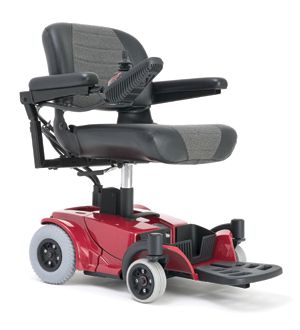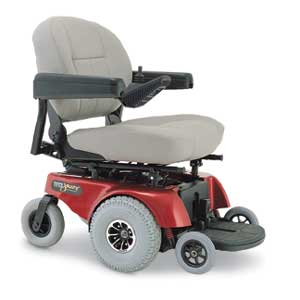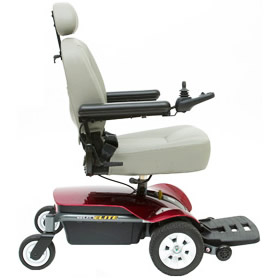Rear-Wheel Drive, Front-Wheel Drive, and Mid-Wheel Drive Wheelchairs
•Rear-Wheel Drive Power Chairs generally have 4 wheels, making them extremely stable. The rear wheels are the wheels actually connected to the wheelchair motor. Rear-wheel drive wheelchairs generally have greater top speeds than other type drive power chairs. The disadvantage of a real-wheel drive wheelchair is the turning radius. While a rear-wheel drive power chair is perfectly capable of using indoors, in tighter quarters it may be more difficult to maneuver around.
Pictured: Pride Mobility Go-Chair
 •Mid-Wheel Drive Power Chairs have a pair of wheels almost directly under where the user sits, so that the user is not sitting in front or behind where the drive wheels are located on other types of wheelchair models. In front and behind the drive wheels are two sets of caster wheels to keep the chair balanced. In situations where the ground slopes downwards and back up again, there is a possibility of getting your the wheelchair wedged in a position where the casters will keep your middle wheel from touching the ground. In this position, the chair will be unable to move without the help of another person. One advantage of the mid-wheel drive wheelchair is the turning radius. Mid-wheel drive chairs have the best turning radius of all, making them perfect for users that plan on primarily using their power chair indoors and in tight quarters. Other than the very small possibility of getting stuck on unlevel ground in a mid-wheel drive wheelchair, mid-wheel drive wheelchairs are the most popular model for a reason, so don't let this one disadvantage steer you away.
•Mid-Wheel Drive Power Chairs have a pair of wheels almost directly under where the user sits, so that the user is not sitting in front or behind where the drive wheels are located on other types of wheelchair models. In front and behind the drive wheels are two sets of caster wheels to keep the chair balanced. In situations where the ground slopes downwards and back up again, there is a possibility of getting your the wheelchair wedged in a position where the casters will keep your middle wheel from touching the ground. In this position, the chair will be unable to move without the help of another person. One advantage of the mid-wheel drive wheelchair is the turning radius. Mid-wheel drive chairs have the best turning radius of all, making them perfect for users that plan on primarily using their power chair indoors and in tight quarters. Other than the very small possibility of getting stuck on unlevel ground in a mid-wheel drive wheelchair, mid-wheel drive wheelchairs are the most popular model for a reason, so don't let this one disadvantage steer you away.Pictured: Pride Jazzy 1113 ATS

•Front-Wheel Drive Power Chairs obviously have their drive wheels in front of the chair and wheelchair user. As far as turning radius goes, it is in the middle of rear and mid-wheel drive wheelchairs. Front-wheel drive wheelchairs operate on uneven and hilly terrain better than the other two types of wheel-driven chairs. Top speeds are a little slower than rear-wheel drive models, but are generally the same speed as mid-wheel drive wheelchairs.
Pictured: Pride Jazzy Select Elite



